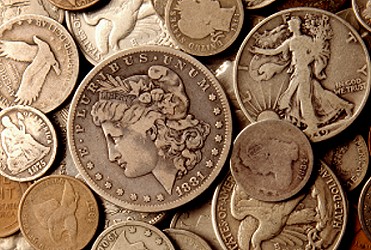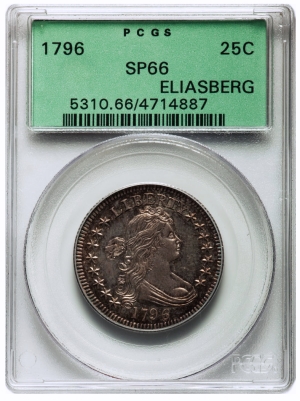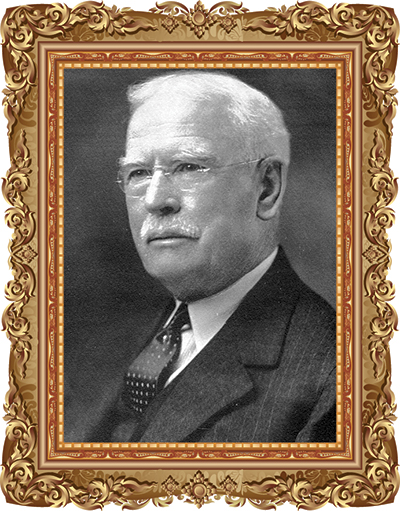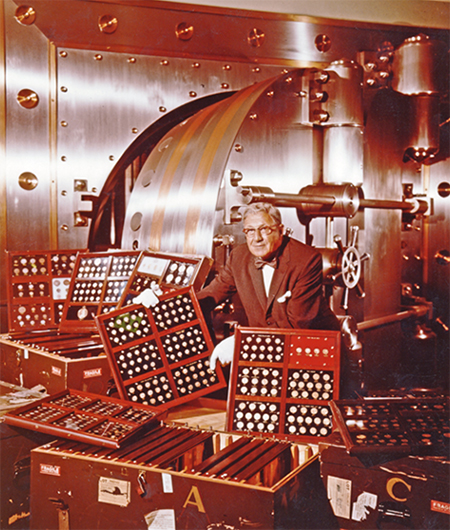
By Harvey Stack – Co-Founder, Stack’s Bowers Galleries ……
The Nixon Shock
The year 1972 followed closely some of the events and happenings in the earlier years in the hobby.
It was in this year of economic inflation that the hobby experienced strong growth. Many collectors new to the hobby joined the American Numismatic Association (ANA). The Professional Numismatic Guild (PNG) continued to grow, attracting new members amongst the ranks of professional rare coin, currency, and bullion dealers. Coin newspapers, especially the weekly editions, grew their subscriber bases, while local coin clubs either launched or expanded their memberships.
The price of gold and silver advanced well beyond the $42.00 price threshold set in place by the Nixon administration, peaking at $70. The inflationary happenings in the investment markets also impacted Main Street, with the cost of housing, fuel, food, and other necessities becoming more expensive for most Americans.
As a result of this economic uncertainty, many people looked for alternative places to invest.
Loose Change
The popularity of coin collecting went beyond the closed loop of professional and club hobby publications. Articles about coin collecting appeared frequently in national newspapers, and magazines.
Many people became interested in the hobby because the final few silver coins struck before 1965 were still being found in circulation. Since the change from silver to clad, searching through change to extract the more valuable coins had become a national pastime.
The premium that silver dimes, quarters, half dollars, and dollar coins brought over face value served as a valuable enticement for the bullion industry as it gave potential investors a clear picture of the diminishing value of the dollar under the fiat money system.
 Even if the coins were circulated and not what professionals would consider collectible, their value as silver coins was enough to entice a generation of people to become interested in coins. As a result, Whitman and its competitors made a good business in producing coin albums. These albums proved to be an important entry point into the coin collecting hobby for a whole generation of our most important collectors.
Even if the coins were circulated and not what professionals would consider collectible, their value as silver coins was enough to entice a generation of people to become interested in coins. As a result, Whitman and its competitors made a good business in producing coin albums. These albums proved to be an important entry point into the coin collecting hobby for a whole generation of our most important collectors.
This period of widespread public interest was not without risks.
Seeing the potential to make a quick buck, many promotors and non-professional people entered into the coin business. Some tried their hand at the business in earnest, while others bought (or had made for them) deceptive coins. Some were fake altogether, while others had altered dates and mint marks, or had their surfaces altered to make the coins appear more appealing. This wrought havoc in the rare coin marketplace as the community of knowledgable dealers were unable to protect the public from these unethical dealers and their deceptive practices.
Not that they didn’t try.
As the ANA and PNG became fully aware of the scope of the problem, they began to work together to develop some methodology for educating collectors and enforcing fair practices in the dealer community.
Each organization convened to work on solutions to this vexing problem, understanding full well that they could not protect everybody, or regulate every mom and pop store or flea market vendor that offered coins for sale.
Ultimately, both organizations recognized that to protect the hobby, they would need to get the United States Congress involved. A legislative fix, they thought, could discourage or stop counterfeiters from exploiting collectors with fake coins.
This work led to the passing of the Hobby Protection Act of 1973.
A Special Request from Louis E. Eliasberg
As most collectors know, Louis E. Eliasberg had become nationally-known for building the only complete collection of United States gold, silver, and copper coins ever assembled.
His collection started humbly enough, as Eliasberg began populating his cabinet with common issues. In 1941, however, with the acquisition of the Clapp Collection (a deal brokered through Stack’s), Eliasberg’s pursuit of numismatic history received a major boost.

Clapp was a successful banker, who was also enthralled with numismatics.
Buying at the right time, Clapp used the opportunity to assemble a magnificent collection populated with many rare coins that he purchased over several decades from the leading collections of the time. Not only was the Clapp collection significant, the pedigrees predating the coins’ inclusion in Clapp were significant as well. After Clapp passed away, his estate requested that Stack’s find a buyer.
It was a golden opportunity to Eliasberg, who had amassed enough of fortune as a businessman to buy the collection intact.
Stack’s sent my father, Morton, and my uncle Joseph to Baltimore, where they detailed the contents of the Clapp Collection to Louis E. Eliasberg. It took him a few days to mull over the deal.
One of the things that drew Eliasberg to collecting coins was the idea of owning gold coins. After the passage of the Gold Act of 1933-’34, gold ownership was heavily restricted. Coins of numismatic value could be collected, but there was always a danger that the owner of these coins would have to prove that the coins had numismatic value and were not being held as bullion.

One of the factors that influenced Eliasberg’s decision to buy the Clapp collection was the belief that it would fortify his claim that he was a serious numismatist. Joseph and Morton backed this belief up, telling Eliasberg that buying the Clapp Collection intact would make him a serious player in numismatic circles. It took him one day to decide and with the purchase the Eliasberg Collection grew to include virtually ever coin in the U.S. series starting with colonials and continuing to the present day.
The Clapp estate agreed to the price of $100,000 plus a commission of $10,000 for Stack’s for processing the collection and securing the deal.
The $110,000 sale price of the Clapp Collection was historic. In 1941, most rare coins would fetch only a few dollars over face. It turned out to be the best investment that Eliasberg would ever make, he said as much when Norman and I visited him to discuss his collection in 1972.
Eliasberg was a fantastic ambassador for the hobby. During the World War II years, he wanted to show his collection to as many people as he could. The Eliasberg coins made many public appearances at this time. At bank openings, anniversaries, or special promotional days, if you lived in the Baltimore, Maryland area, you might have had the good fortune of seeing the collection.
With all the superlatives attached to the collection and as the only (virtually) complete collection of U.S. coins ever assembled, the notoriety of Eliasberg’s coins grew nationwide. He and his coins were featured in many well-known magazines. Eliasberg made the numismatic hobby better known worldwide!
What is lesser known about the collection is that he didn’t stop with American coins.
After gaining widespread fame for his U.S. coins, Eliasberg ventured into collecting the gold coins of the world and assembled a representative collection of this material.
He felt that gold was the major commodity that made all currency have “value” and wanted to add world gold coins to his collection in order to tell the story of gold’s economic impact on civilization through the thousands of years that it was used as currency. He saw his coin collection as a great educational tool. By exhibiting it often, he attracted many people, who were interested in learning about monetary history.

In 1972, as Eliasberg was getting older and had unfortunately fallen ill. He called our offices in New York and said that he wanted to create a new inventory of his collection. This evaluation, he thought, would be necessary if the collection was to continue to be exhibited or perhaps, be put on sale. Norman and I flew to Baltimore and carried out the job that he requested.
During our meetings with Eliasberg (we knew him well enough to call him “Lou”), he explained his belief that he had to sell his collection intact to either a wealthy individual (the collection’s value had grown precipitously since 1941), or to a financial services company, either a bank or a Wall Street firm. Eliasberg wanted the collection to continue to be displayed and thought it would be great if the collection toured around the country. After which, Eliasberg felt, they could sell the pieces of the collection as they saw fit.
He had another idea about exhibiting the coins, but never thought of pursuing it. During the postwar years, many important collections of art, antiques and historical items were exhibited nationwide by rail. Eliasberg considered putting together a tour-by-rail of his coin collection by modifying a few boxcars and touring as many cities and states as he could. This would have been a grand spectacle and something unique for the hobby of numismatics. Unfortunately, it never came to be.
After spending a few days with Eliasberg and his coins in Baltimore, we headed back to our offices in New York, where I would spend several months considering what to do with this most important of numismatic properties.
Stack’s Drops the Hammer
In 1972, Stack’s received consignments from several major collections and helped many build upon their sets and helped many others start their adventures in coin collecting. When it comes to collecting rare coins, the primary sources of material are collections that were formed earlier.
In February, we sold an assortment of 1274 coins from various consignors. In March, we sold the Angelo Turrini Collection of U.S. Coins (1293 lots). In June, we sold coins from the estate of Russel Hein (1161 coins). And, in December, we sold the collection of LLoyd Meyers (878 coins).

Perhaps, the most significant sale of the year was for coins from the Arthur Stewart Collection. Stewart was an old-time collector and was an early member of the American Numismatic Association. His ANA member number was 184.
Over the course of his collecting career, he assembled a wonderful type and date collection of U.S coins which we sold in May. The entire collection was 1808 lots, including many type and Proof coins.
We also sold a spectacular collection belonging to collector S.S. Forrest. Forrest built his collection by focusing on early Proofs and rare type.
World coin collectors were delighted by the opportunity to buy many spectacular gold coins from around the world, when we offered the collection of Alfred Globus in October. Globus famously used his gold coin collection to secure a loan that saved his chemical business when it was struggling in the late 1940s.
Fortunes can be made or lost through coins.
After selling the Globus Collection, we offered the Winner Delp collection of rare U.S. coins. Delp was an electrical engineer, who worked on computers. Delp built his collection over a number of years by working with Stack’s. He had superb quarters from 1796 and 1827, a beautiful 1797 half dollar, an 1858 dollar, and an 1884 Trade dollar. His group of early gold types were a prize as well. His collection spanned 973 lots.
The 1972 auction season concluded in December with the Estate of Lloyd Meyers, a veteran collector, who for decades, enjoyed assembling coins that pleased him in the U.S. series.
All in all, Stack’s was pleased to have been able to offer a variety of old time collections, many of which we were instrumental in building, and others built by collectors, with whom we worked for a number of years. 1972 was a monumental year for the hobby of coin collecting.
In my next part about GROWING UP, I will turn my focus to what occurred in 1973, another wonderful year for our great hobby!
* * *
Links to Earlier Parts:
1928-35 | 1935-45 | 1945-51 | 1951-52 | 1954 | 1955-56 | 1957 | 1958-59 | 1960 | 1961-62 | 1963 | 1964 | 1965 | 1966 | 1967 | 1968-69 | 1970-1971





C’est très intéressant, surtout pour la france en déficits….. Merci beaucoup !